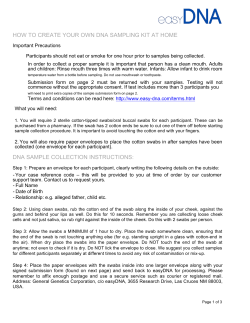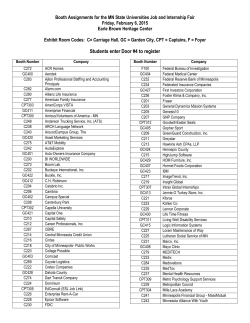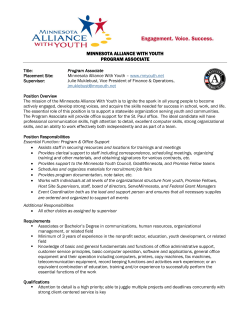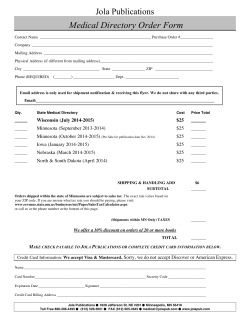
Avian Influenza Virus testing 4-13
Avian Influenza Virus testing 4-13-15 1. Contacts for Minnesota Veterinary Diagnostic Laboratory (MNVDL) sample submission a. Regular business hours (7:30AM to 4:30PM) Samples can be delivered to the MNVDL front desk (1333 Gortner Ave., St. Paul,MN 55108). Please call the MNVDL (800605-8787 or 612-625-8787)and contact Dr. Porter (primary contact) or Dr. Rossow (secondary contact) if 50 or more samples will be delivered. Please also alert us if the clinical signs indicate if the samples are high risk. The clinical signs of severe/high risk disease in turkeys and chickens include one or more of the following: dramatic increase in depression/lethargy, high death loss, respiratory disease, and neurologic disease. b. After hours and weekend submissions for healthy bird/surveillance samples Samples can be delivered by courier to the small animal emergency desk at the University of Minnesota Veterinary Teaching Hospital (1365 Gortner Ave, St. Paul MN 55108). Samples will be logged in at the emergency desk, placed in a cooler and picked up by VDL personnel for testing. Samples that are delivered to the VMTH before 6 PM will be tested and reported on the same day. Clients are urged to collect and deliver samples in a timely manner and to contact Dr. Porter or Dr. Rossow if 1) a high risk specimen is delivered and 2) a large number of samples will be delivered. c. After hours and weekend submissions for birds with signs of disease/high risk Please always contact Dr. Porter or Dr. Rossow when samples from these birds are to be delivered. Dr. Porter will be the primary on call person and Dr. Rossow will be the secondary person on call. Dr. Porter or Dr. Rossow will come to the MNVDL to collect the samples from the courier. d. Contacts Dr. Porter - 612-624-7400(office), 952-847-3476 (cell), porte349@umn.edu Dr. Rossow - 612-625-7043 (office), 651-726-4796 (cell), rosso003@umn.edu 2. Testing at the MNVDL a. Samples from surveillance flocks The VDL is conducting PCR tests twice per day 8:00 am and 2:00 pm seven days a week (testing is conducted on both Saturday and Sunday). Please collect and transport samples as soon as possible. Samples that arrive at the MNVDL by 2:00 PM will be tested and reported on the same day. Negative results will be available on the VDL website. All positive AI results will be reported on the same day to the MBAH, NVSL, submitting veterinarian and the farm owner. Sample processing, testing and entering final results takes approximately 4 hours but may be longer if numerous samples are being tested at one time. In accordance with the Americans with Disabilities Act, this information is available in alternative formats of communication upon request by calling 651-296-2942. TTY users can call the Minnesota Relay Service at 711 or 1-800-627-3529. The Board of Animal Health is an equal opportunity employer and provider. 3. Result reporting of positive samples a. Dr. Porter or Dr. Rossow will contact Dr. Collins (MNVDL Director), the Minnesota Board of Animal Health, the National Veterinary Services Laboratory (NVSL) , Dale Lauer (Minnesota Poultry Testing Laboratory Director - MNPTL) and the submitting veterinarian and the farm owner. b. Technicians will enter results into the MNVDL information system and will be immediately viewable on the website (www.vdl.umn.edu). Clients and veterinarians can have access to their results by contacting the MNVDL (800-605-8787) to establish a user name and a password. Veterinarians can view results from multiple clients. Owners will only have access to their results. 4. Required information for submissions (incomplete information will delay reporting of results) a. Federal Premise ID (if known) : b. Bird age: c. Breeder or commercial birds d. Clinical signs (please circle): lethargy, high death loss, respiratory disease, digestive disease, neurologic disease, other - please list e. Flock size f. Number of dead birds g. Owner (at the site) name and address h. Street address i. City j. County k. Name of the person collecting the samples l. Communicate results to (provide contact information if different/in addition to individual listed above): 5. How to collect swab samples. a. Dacron swabs should be used for samples collection. b. Select sick or dead birds to swab if these are observed. In accordance with the Americans with Disabilities Act, this information is available in alternative formats of communication upon request by calling 651-296-2942. TTY users can call the Minnesota Relay Service at 711 or 1-800-627-3529. The Board of Animal Health is an equal opportunity employer and provider. c. Tracheal/oropharyngeal (TR/OP) swabs are preferred for gallinaceous poultry. The opening of the trachea and mouth can be swabbed (avoiding the esophagus), bringing the swab up through the choanal cleft (collectively referred to as TR/OP swab) - the sinuses drain into the choanal cleft, therefore swabbing will capture material from the upper respiratory tract. d. Cloacal (CL) or vent swabs are preferred for domestic waterfowl and wild birds. National wild bird surveillance efforts recommend to put 1 OP and 1CL swab from an individual bird into a single tube; however, avoid pooling swabs from different wild birds into a single tube. e. Preferably place collected swabs in media (brain heart infusion broth) supplied by the MNPTL. Sterile saline or sterile PBS (phosphate buffered saline) can also be used. Although dry swabs are not preferred, swabs can be submitted without media, PBS or saline, particularly if they will be delivered to the VDL quickly. The recommended pooled swab number for most birds is 5 swabs per 3 ml medium; however, 11 swabs per 5ml medium is also acceptable for chickens and turkeys. 6. Packaging, biosecurity and couriers a. Surgical or similar type gloves should be used for sample collections. b. Double bag samples in plastic bags (whirl pac bags or ziplock bags are fine). To help minimize contamination, please spray the outside bag with an appropriate disinfectant such as 10% solution of chlorox, Lysol, Virocid. Diluted chlorox is only remains active for one week after dilution. Place the submission form in a separate plastic bag and include it in container. Place the samples in a rigid container such as a Styrofoam box. Keep samples chilled with cold pacs. Do not use regular ice. c. The best practice is to not have the people collecting the samples transport them to the MNVDL. Any individual can be a private courier. Please have couriers identified before they are needed. In accordance with the Americans with Disabilities Act, this information is available in alternative formats of communication upon request by calling 651-296-2942. TTY users can call the Minnesota Relay Service at 711 or 1-800-627-3529. The Board of Animal Health is an equal opportunity employer and provider. HPAI (Avian Influenza) Sample Submissions via Courier Service The Minnesota Board of Animal Health has established two collection sites for producers/bird owners to bring tracheal swab samples for testing. Samples delivered before the designated time will be couriered to the University of Minnesota Veterinary Diagnostic Laboratory (VDL) in St. Paul the same day and tested for HPAI (Highly Pathogenic Avian Influenza). There is no cost to the producer if this testing is conducted as part of control area surveillance, product movement or sick bird calls. Sample collection sites: Melrose Fire Hall 1) 405 2nd Ave SE, Melrose, MN 56352 Courier will leave the Drop Off Site at 12:00 PM. All samples must be at the collection site prior to 12:00 PM for delivery that day, collection site will be open from 9:00 AM – Noon. Contact Leslie Michaud at (802) 338-7466 with questions. Kandiyohi Emergency Operations Center (EOC) 2) 2201 Northeast 23rd Street, Willmar, MN Courier will leave the EOC twice daily, 9:00 AM and 3:00 PM. All samples must arrive prior to 3:00 PM for delivery that day, samples arriving later in the day will go with shipments the next day. Contact the Kandiyohi EOC at (320) 214-6700, ext. 3804 for more information. • • • • • • Samples delivered by the courier service from the 9:00 am (Willmar) and 12:00 pm (Melrose) pick-up times will be tested the same day. All samples must be properly identified, bagged and accompanied by a properly completed submission form. In order to receive test results in a timely manner, samples for permitted or pre-market movement should be dropped off at the Kandiyohi EOC for 9:00am pick-up or Melrose for the Noon pick-up. Producers can deliver samples to the UM-VDL at their own expense. Additional information can be found at the Board’s website - https://www.bah.state.mn.us/ More information on Melrose sample drop off can be found by contacting the Minnesota Poultry Testing Laboratory (320-231-5170) or Minnesota Board of Animal Health. In accordance with the Americans with Disabilities Act, this information is available in alternative formats of communication upon request by calling 651-296-2942. TTY users can call the Minnesota Relay Service at 711 or 1-800-627-3529. The Board of Animal Health is an equal opportunity employer and provider.
© Copyright 2025









